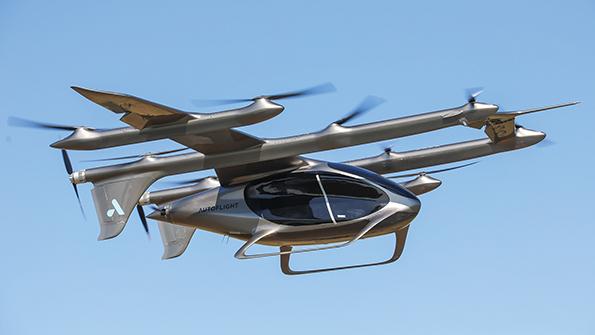
AutoFlight’s fourth-generation eVTOL was styled by Mini-to-McLaren automotive designer Frank Stephenson.
AutoFlight, a startup with operations in China and Europe, has completed the longest flight to date by an electric vertical takeoff and landing (eVTOL) aircraft, its fourth-generation Gen4 demonstrator flying 250.6 km (155.6 mi.) on a single charge.
The remotely piloted flight, on Feb. 23 in Shanghai, included a vertical takeoff and landing and narrowly exceeded the existing record of 248.8 km set by Joby Aviation’s S4 in July 2021.
- Gen4 design increases numbers of lift rotors
- Design close to certification-conforming eVTOL
The Gen4 is the latest iteration of the lift-plus-cruise design for AutoFlight’s piloted three-passenger Prosperity I eVTOL air taxi. The first-generation proof-of-concept V1500 initially flew in October 2021. The latest prototype introduces a number of design changes including the addition of two outboard wing booms that increase the number of lift rotors to 10 from eight on previous aircraft.
Adding the wing booms allows zero overlap between the lift rotors, improving efficiency and reducing noise. “This is [the] first aircraft that is hitting the mark on how quiet it can be,” AutoFlight President Omer Bar-Yohay says. The Gen4 aircraft is not a conforming prototype for certification tests. “We are inching closer to conformity, but we are not quite there,” he says.
One feature that is not conforming on the Gen 4 is the three pusher propellers for wing-borne propulsion, two on the inboard wing booms and one on the aft fuselage. The conforming aircraft will have two pusher props. “Having three allows us to go to the edge of the flight envelope safely to test failure modes and avoid the need to use a recovery parachute,” Bar-Yohay says.
The 1.5-hr. endurance test flight demonstrated the planned capability of the 2,000-kg (4,400-lb.) gross-weight Prosperity I, which has a design range of 250 km at a cruise speed of 200 kph (124 mph). After a vertical takeoff at just more than 1,800-kg gross weight and transition to wing-borne flight, the aircraft completed 20 circuits of a 2-km-radius flight track while being remotely piloted from the ground.
The endurance flight allowed AutoFlight “to fly at the safe edge of battery capacity and show we are able to safely land vertically,” he says. “We were able to see how the aircraft behaves as the voltages start to go down and amps go up. It was a good validation exercise.” The Gen4 is powered by commercially available lithium-ion pouch cells provided by a Chinese supplier.
“We intend to fly the Gen4 quite a lot,” says Bar-Yohay, adding AutoFlight plans to build more than one of the aircraft for flight testing in China and in Europe. The company is unusual for an eVTOL startup in that it plans to certify the Prosperity I in Europe but build most of the aircraft in China. This version of the aircraft will have European and U.S. avionics for certification and security. A different version with local avionics will be certified in China.
AutoFlight differs from other companies that are building up their manufacturing capability alongside certifying their aircraft, as the Chinese arm has an established capability to produce another aircraft in a short time at reasonable cost. “So we can iterate a bit more and a bit better than most, if not than anyone,” he says. The company anticipated having a conforming design by year’s end and is aiming for European type certification in 2025.
Based in Augsburg, Germany, AutoFlight Europe is the design organization for the Prosperity I and is pursuing certification under the European Union Aviation Safety Agency’s (EASA) Special Condition for VTOL (SC-VTOL). The German arm is in the process of obtaining design organization approval (DOA) from EASA. The company will then contract with AutoFlight in China to produce parts for the European-certified aircraft.
“There are two sister companies, one a supplier to the other,” Bar-Yohay says. This enables the startup to tap into an existing supply chain. AutoFlight has an R&D and assembly center in Kunshan, Jiangsu province, and a composites manufacturing plant in Jining, Shandong province. Originally a manufacturer of uncrewed aircraft, the company produces its own airframes, propellers, electric motors and controllers, battery packs, power management units, air data sensors and autopilots.
AutoFlight plans to establish final-assembly facilities for the Prosperity I in China, Europe and the U.S. This is because eVTOL certification is not harmonized, Bar-Yohay says. While EASA’s SC-VTOL certification requires the same 10-9 safety level as commercial aviation, the FAA’s Part 21.17(b) accepts a lower level and the Civil Aviation Administration of China is “10 to the minus something else,” he says, so performing final assembly locally makes it easier to work with regulators.
